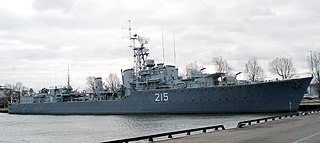Related Research Articles

HMCS Haida is a Tribal-class destroyer that served in the Royal Canadian Navy (RCN) from 1943 to 1963, participating in World War II and the Korean War. She was named for the Haida people.

The Royal Canadian Sea Cadets is a Canadian national youth program sponsored by the Canadian Armed Forces and the civilian Navy League of Canada. Administered by the Canadian Forces, the program is funded through the Department of National Defence, with the civilian partner providing support in the local community. Cadets are not members of the Canadian Armed Forces.

USS MacKenzie (DD–175) was a Wickes-class destroyer in the United States Navy following World War I, later transferred to the Royal Canadian Navy as the Town-class destroyer HMCS Annapolis.
Qu'Appelle may refer to:
Six ships of the Royal Navy have been named HMS Foxhound. A seventh was planned but never completed:
Four Canadian naval units have been named HMCS Ottawa.
Rear Admiral Robert Walter Timbrell, CMM, DSC, CD, Royal Canadian Navy was the first Canadian to be decorated with the Distinguished Service Cross during the Second World War. This followed his part in Operation Dynamo where he was personally responsible for the evacuation of 900 troops from the beaches of Dunkirk.
Several Canadian naval units have been named HMCS Chaudiere.

HMCS Qu'Appelle was a Mackenzie-class destroyer that served in the Royal Canadian Navy and later the Canadian Forces. The ship's insignia and logo was the head of a fox facing forward centered in a diagonal line double white with a red center sqiggley line from the top left to bottom right. The moniker of the ship was "Follow the Fox".
Several units of the Royal Canadian Navy have been named HMCS Stormont.

Vice Admiral Henry George "Harry" DeWolf was a Canadian naval officer who was famous as the first commander of HMCS Haida during the Second World War.
Two Canadian naval units have been named HMCS Assiniboine.
Several Canadian naval units have been named HMCS Restigouche.
Several Canadian naval units have been named HMCS St. Laurent.
Several Canadian naval units have been named HMCS Gatineau.
Several Canadian naval units have been named HMCS Skeena.

HMS Foxhound was one of nine F-class destroyers built for the Royal Navy in the mid-1930s. Although she was assigned to the Home Fleet, the ship was detached as part of the Mediterranean Fleet to enforce the arms blockade imposed by Britain and France on both sides during the Spanish Civil War of 1936–39. Several weeks after the start of the Second World War in September 1939, Foxhound helped to sink a German submarine and participated in the Second Battle of Narvik during the Norwegian Campaign of April–June 1940. The ship was sent to Gibraltar in mid-1940 and formed part of Force H where she participated in the attack on Mers-el-Kébir. Foxhound escorted the aircraft carriers of Force H as they flew off aircraft for Malta and covered convoys resupplying and reinforcing the island until late 1941. During this time the ship helped to sink another German submarine.
Rear-Admiral William Moss Landymore, OBE, CD was a Canadian naval officer.
The Battle of Pierres Noires was a naval action that occurred during the Allied Operation Dredger, involving several Royal Canadian Navy (RCN) destroyers and a German Kriegsmarine U-boat with escorts near Brest, France. The RCN force managed to sink or damage some of the escorts on the surface, but the U-boat was able to escape.
Several units of the Royal Canadian Navy have been named HMCS Royal Mount.